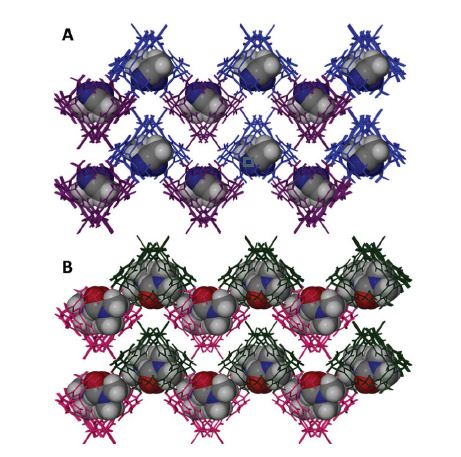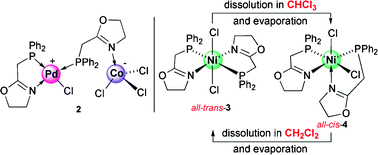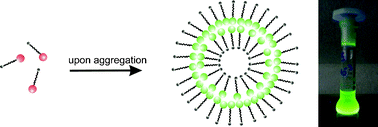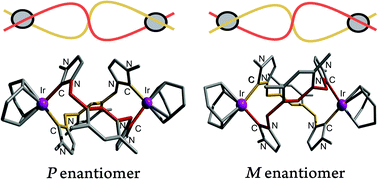
Dalton Trans., 2011, 40(45): 11985-12396
Our themed issue on self-assembly in inorganic chemistry is now online. Guest editors Paul Kruger and Thorfinnur Gunnlaugsson introduce the issue in their editorial.
Self-assembly in inorganic chemistry
Paul E. Kruger and Thorfinnur Gunnlaugsson
Dalton Trans., 2011, 40, 12003-12004
DOI: 10.1039/C1DT90162A
The front cover highlights work from Gale, Light, Ogden et al. examining the coordination of 2,5-dicarbothioamidopyrroles. De Cola et al. feature on the inside front cover with their description of a new class of water soluble metallosurfactant molecules based on luminescent neutral iridium(III) complexes. Both cover articles will be free for 6 weeks so do take a look.
Further insight into the coordination of 2,5-dicarbothioamidopyrroles: the case of Cu and Co complexes
Louise E. Karagiannidis, Philip A. Gale, Mark E. Light, Massimiliano Massi and Mark I. Ogden
Dalton Trans., 2011, 40, 12097-12105
DOI: 10.1039/C1DT10441A
Aggregation induced colour change for phosphorescent iridium(III) complex-based anionic surfactants
Matteo Mauro, Gabriele De Paoli, Matthias Otter, Daniela Donghi, Giuseppe D’Alfonso and Luisa De Cola
Dalton Trans., 2011, 40, 12106-12116
DOI: 10.1039/C1DT11251A
The perspective by Jim Thomas gives an overview of research on sensor systems featuring discrete metal ion directed self-assembled architectures.
Metal ion directed self-assembly of sensors for ions, molecules and biomolecules
Jim A. Thomas
Dalton Trans., 2011, 40, 12005-12016
DOI: 10.1039/C1DT10876J
Also in the issue is the HOT communication from Stephen Faulkner and co-workers. You can read Helen’s previous blog post on this article here.
Self-assembly between dicarboxylate ions and a binuclear europium complex: formation of stable adducts and heterometallic lanthanide complexes
James A. Tilney, Thomas Just Sørensen, Benjamin P. Burton-Pye and Stephen Faulkner
Dalton Trans., 2011, 40, 12063-12066
DOI: 10.1039/C1DT11103E
We’d like to thank the Guest Editors and all the authors for their contributions – it really is a fantastic issue and we hope you enjoy reading it. Why not take a look at the articles today and blog your comments below.
 Rational design of MOFs is a complex task with a range of variables including ligands, metals, reaction conditions and solvents, this HOT Communication in Dalton Trans. details the synthesis of a novel metal organic framework (MOF) using an aromatic linker and CdBr2. Leonard Barbour and Marike du Plessis synthesised the framework with different solvents and discovered different packing modes for the different solvent systems…… to find out more about their discoveries read the full Communication in Dalton Transactions.
Rational design of MOFs is a complex task with a range of variables including ligands, metals, reaction conditions and solvents, this HOT Communication in Dalton Trans. details the synthesis of a novel metal organic framework (MOF) using an aromatic linker and CdBr2. Leonard Barbour and Marike du Plessis synthesised the framework with different solvents and discovered different packing modes for the different solvent systems…… to find out more about their discoveries read the full Communication in Dalton Transactions. 













 Transition metal complexes bearing functional P,N-type ligands attract much attention because they combine hard nitrogen donor(s) and soft phosphorus donor(s) and offer considerable chemical and structural diversity. In this HOT Article, Braunstein et al. report several palladium/cobalt and nickel complexes with phosphino-oxazoline ligands. Some of the nickel complexes were further checked for their ethylene reactivity, and showed activity for ethylene non-selective oligomerization. Interestingly, a reversible interconversion transform phenomena was observed between a couple of the isomeric Ni-complexes with variation of the solvent between CH2Cl2 and CHCl3.
Transition metal complexes bearing functional P,N-type ligands attract much attention because they combine hard nitrogen donor(s) and soft phosphorus donor(s) and offer considerable chemical and structural diversity. In this HOT Article, Braunstein et al. report several palladium/cobalt and nickel complexes with phosphino-oxazoline ligands. Some of the nickel complexes were further checked for their ethylene reactivity, and showed activity for ethylene non-selective oligomerization. Interestingly, a reversible interconversion transform phenomena was observed between a couple of the isomeric Ni-complexes with variation of the solvent between CH2Cl2 and CHCl3.
 Braunstein and co-workers have formed a dinuclear Ir(I) complex with a bis-NHC ligand in situ from
Braunstein and co-workers have formed a dinuclear Ir(I) complex with a bis-NHC ligand in situ from